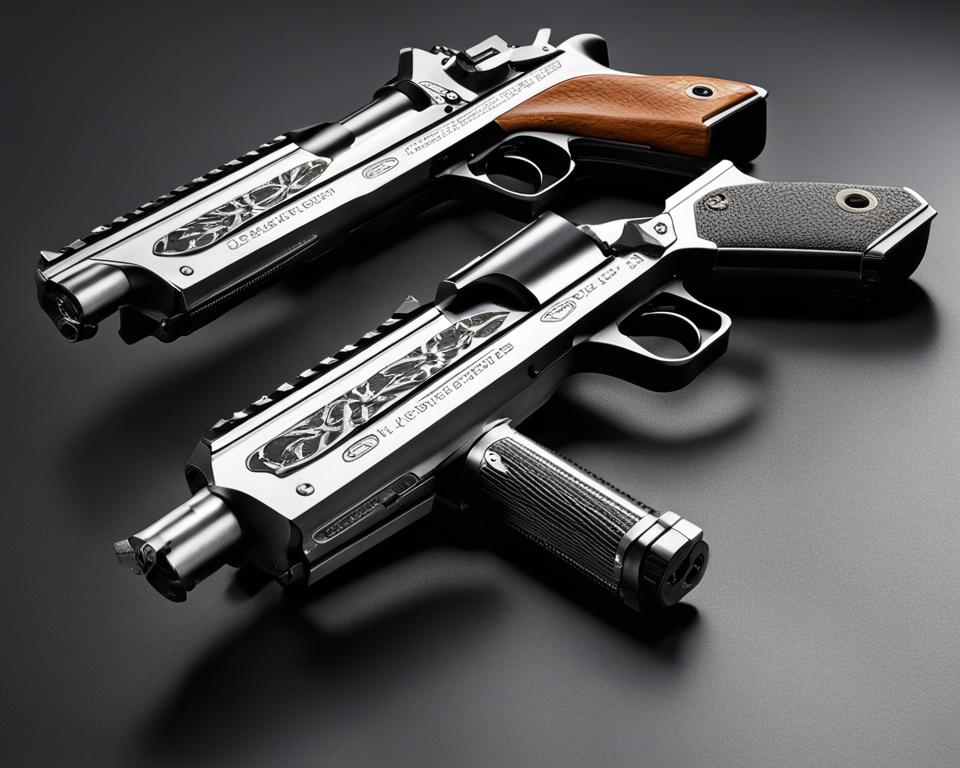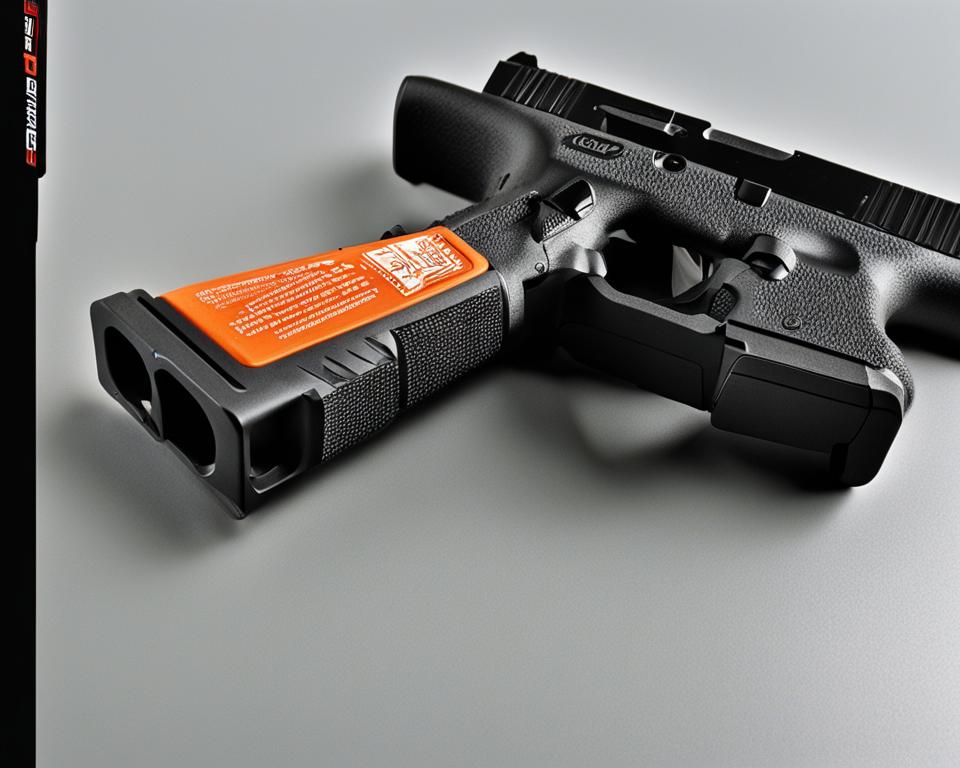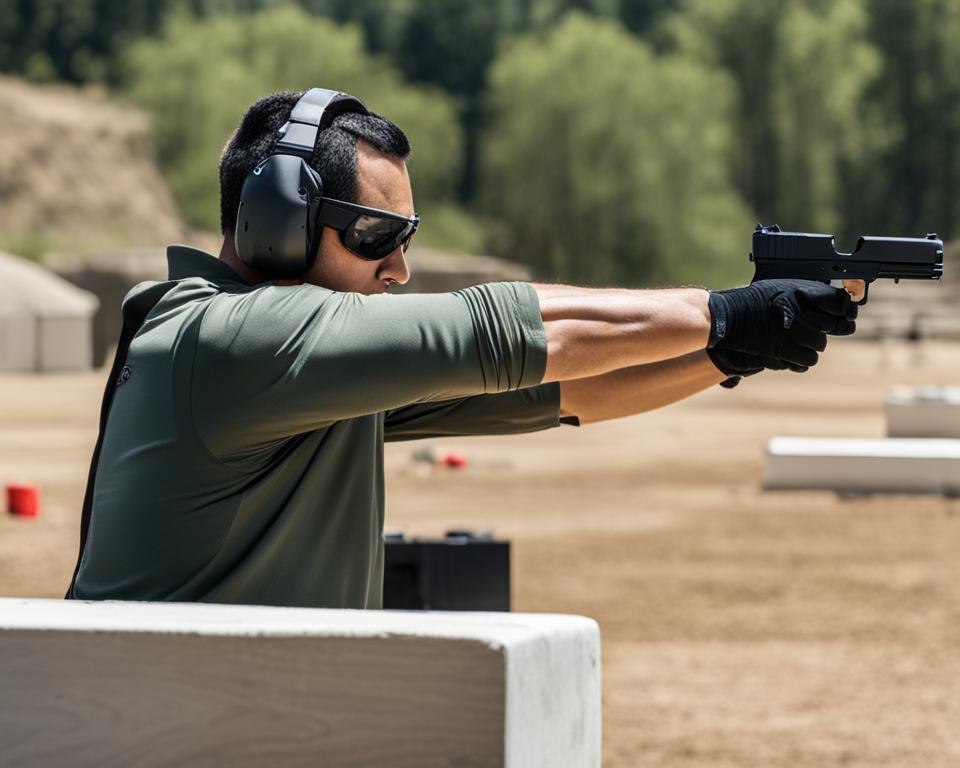The Glock 26 has gained popularity among competitive shooters for its versatility and reliability. Whether serving as a backup to a primary concealed carry weapon or used as a discreet carry option, the G26 excels in shooting sports events. Many shooters compare its shootability and balance to larger Glock models, like the G19. The compact size and shorter grip of the G26 allow for better concealment, making it suitable for various carry methods, such as AIWB or IWB.
Despite its compact design, the Glock 26 is easy to shoot well, providing consistent performance on the range. It has become a favorite among both seasoned competitors and beginners looking to make their mark in the world of competitive shooting. In this article, we’ll explore strategies and insights for utilizing the Glock 26 in the competitive shooting arena.
Key Takeaways:
- The Glock 26 is a reliable and versatile choice for competitive shooting.
- Its compact size and shorter grip allow for better concealment and various carry methods.
- Shooters achieve similar results to larger Glock models like the G19.
- Upgrading sights, trigger, slide stop, and magazine release can enhance performance.
- Practice, evaluation, and adjustments are necessary for optimal performance.
Optimizing Sight Picture for Improved Accuracy
When it comes to competitive shooting with a Glock 26, optimizing the sight picture is crucial for improved accuracy. While the stock sights on the Glock 26 provide a functional sight picture, they are made of plastic and can wear down easily, especially when drawing from a holster. To enhance durability and low-light visibility, upgrading to steel sights is highly recommended. One notable brand is Ameriglo, which offers steel sights specifically designed for Glock pistols.
For shooters who prefer enhanced aiming capabilities in low-light conditions, night sights are a popular choice. These sights are equipped with tritium inserts that glow in the dark, providing better visibility in dimly lit shooting environments.
Another sight option worth considering is the XS “Big Dot.” While sacrificing some precision, this sight offers faster sight acquisition, which can be beneficial for shooters participating in Glock 26 shooting sports events or competitions where speed is paramount.
https://www.youtube.com/watch?v=RdJnaSHlzSg
| Sight Option | Features | Benefits |
|---|---|---|
| Stock Sights | Plastic construction | Functional sight picture |
| Ameriglo Steel Sights | Durable steel material | Improved longevity and low-light visibility |
| Night Sights | Tritium inserts | Enhanced aiming capabilities in low-light conditions |
| XS “Big Dot” | Larger dot sight | Faster sight acquisition |
Enhancing Trigger Performance for Better Control
Many competitive shooting enthusiasts who own a Glock 26 choose to enhance their trigger for improved control and shooting experience. There are several popular modifications that can be made to optimize the trigger performance of the Glock 26.
One common modification is polishing the trigger engagement areas. By carefully smoothing out the surfaces, shooters can achieve a smoother trigger pull and a distinct reset, enhancing their overall control and accuracy while shooting. However, it is essential to exercise caution when polishing the trigger engagement areas to avoid removing too much material or altering the engagement angles, which could potentially impact the reliability of the pistol.
Another popular option is installing an aftermarket connector, such as the Ghost, Inc. 3.5-pound connector. This modification can lighten the trigger pull, providing shooters with a lighter and crisper break. However, it is crucial to thoroughly test and evaluate any modifications made to the trigger to ensure that control issues do not arise during competitive shooting scenarios. Safety is paramount, and modifications should only be made after careful consideration and understanding of the potential implications.

In conclusion, enhancing the trigger performance of a Glock 26 for competitive shooting can be a worthwhile endeavor. Through careful polishing of the trigger engagement areas or the installation of aftermarket connectors, shooters can achieve improved control and better shooting performance. However, it is essential to exercise caution, thoroughly test the modifications, and prioritize safety to ensure that the modified Glock 26 remains reliable and safe in competitive shooting situations.
Upgrading Slide Stop and Magazine Release for Increased Efficiency
The Glock 26’s slide stop and magazine release can be upgraded to enhance efficiency during competitive shooting. While the factory extended magazine release can be sharp and uncomfortable for some shooters, options like the Vickers Tactical provide a smoother, rounded design. These enhancements make it easier to execute quick and reliable magazine changes. Additionally, swapping the factory slide stop for a Vickers slide stop offers stronger serrations and improved ergonomics for better slide manipulation. These subtle upgrades contribute to better overall performance in shooting competitions.
Take a look at the comparison table below to see the benefits of upgrading the slide stop and magazine release:
| Factory Slide Stop | Vickers Slide Stop |
|---|---|
| Smooth but limited serrations | Enhanced serrations for better grip |
| Standard size and shape | Improved ergonomics for easy manipulation |
| Smoother, rounded magazine release for quick and reliable magazine changes | |
By upgrading to a Vickers slide stop and magazine release, competitive shooters can significantly improve their shooting performance with the Glock 26. The enhanced serrations and ergonomic design of the Vickers slide stop allow for smoother and more secure slide manipulation, resulting in faster follow-up shots and improved control. The rounded magazine release ensures easy and efficient magazine changes, reducing the risk of fumbling or dropping magazines during intense shooting events.
Check out the image below to see the Vickers Tactical slide stop and magazine release:

Investing in these upgrades not only enhances the shooter’s overall efficiency and performance but also helps them gain a competitive edge in Glock 26 competitions and shooting events. The subtle enhancements to the slide stop and magazine release add to the shooter’s confidence and proficiency, allowing for faster and smoother firearm manipulations that can make all the difference in competitive shooting.
Acknowledging Learning Curve and Individual Preferences
Transitioning from a 1911 to a Glock 26 for competitive shooting may come with a learning curve. While both pistols can deliver accuracy and consistency, shooters familiar with the 1911 trigger may need to adjust their technique and focus on mastering the Glock trigger reset. Practice, both dry firing and live firing, is crucial to familiarize oneself with the Glock trigger and develop muscle memory.
When it comes to accessories or modifications, individual preferences play a significant role. Each shooter may prioritize different aspects of shooting performance, and it’s essential to consider these preferences when making choices. Whether it’s the grip, sights, or trigger modifications, selecting options that cater to one’s specific needs and preferences can make a noticeable difference in competitive shooting with the Glock 26.
Importance of Reliability and Minimal Modifications
When it comes to competitive shooting with the Glock 26, reliability should always be the top priority. While enthusiasts may be tempted to make modifications to their pistols, it is crucial to ensure that these changes do not compromise the functionality of the firearm. Swapping out internal slide parts, for example, can increase the risk of misfires and compromise reliability.
It is important to thoroughly research and evaluate the potential impact on reliability before proceeding with any modifications. While some shooters may opt for aftermarket parts or custom modifications, it is vital to consider the potential consequences. Certain modifications, such as grip reductions, may impact the resale value and may not be necessary if the stock grip already fits well in the shooter’s hand.
As shooters strive for optimal performance in competitive shooting with the Glock 26, it is important to strike a balance between customization and reliability. While some modifications may offer enhanced performance or ergonomics, it is crucial to weigh their benefits against potential drawbacks. It is always recommended to consult with experienced professionals or gunsmiths to ensure that modifications are conducted safely and do not compromise the pistol’s reliability.
To summarize, prioritizing reliability and minimizing modifications is essential for success in competitive shooting with the Glock 26. Thoroughly researching modifications and their potential impact on reliability will help shooters make informed decisions. By striking a balance between customization and reliability, shooters can maximize performance without compromising the functionality of their Glock 26 pistols.
Constant Practice and Evaluation for Optimal Performance
Achieving optimal performance in competitive shooting with the Glock 26 requires dedicated practice and regular evaluation. By engaging in consistent range sessions, including dry fire practice, shooters can develop proficiency and enhance their understanding of the pistol’s unique characteristics. These practice sessions allow for the refinement of shooting techniques, experimentation with different grips and stances, and the identification of what works best for each individual.
However, practice alone is not enough. It is equally important to evaluate any modifications made to the Glock 26 to ensure they do not hinder performance or compromise reliability. Continual training and assessment of the pistol’s functionality, coupled with adjustments when necessary, are key to improving accuracy, control, and overall performance in competitive shooting.
In the pursuit of optimal performance, shooters should consider seeking professional guidance and leveraging the expertise of experienced competitive shooters. Training and educational courses specific to Glock 26 competitive shooting can provide valuable insights, tips, and techniques to help shooters excel in their chosen discipline.
Remember, constant practice and evaluation are essential for maximizing the performance capabilities of the Glock 26 in competitive shooting. By embracing a mindset of continuous improvement, shooters can unlock their full potential and achieve remarkable results in Glock 26 competitions and other shooting events.
FAQ
Is the Glock 26 suitable for competitive shooting?
Yes, many shooters use the Glock 26 in competitive shooting as a backup or discreet carry option.
How does the Glock 26 compare to larger Glock models like the G19?
Shooters have achieved similar results with the Glock 26, praising its shootability and balance.
Can the sights of the Glock 26 be upgraded?
Yes, upgrading to steel sights can improve durability and low-light visibility.
Are there options for night sights on the Glock 26?
Yes, some shooters prefer night sights for enhanced aiming capabilities.
What trigger modifications can be made to the Glock 26?
Shooters can polish the trigger engagement areas or install aftermarket connectors for a smoother or lighter trigger pull.
Can the slide stop and magazine release be upgraded on the Glock 26?
Yes, upgrading to options like the Vickers Tactical can enhance efficiency during competitive shooting.
Is there a learning curve when transitioning from a 1911 to a Glock 26?
Yes, shooters may need to adjust their technique and focus on mastering the Glock trigger reset.
How important is reliability when making modifications to the Glock 26 for competitive shooting?
Reliability should always be the top priority to ensure that modifications do not compromise functionality.
How can optimal performance in competitive shooting with the Glock 26 be achieved?
Regular practice, evaluation, and adjustments are essential for improved accuracy, control, and performance.

Leave a Reply